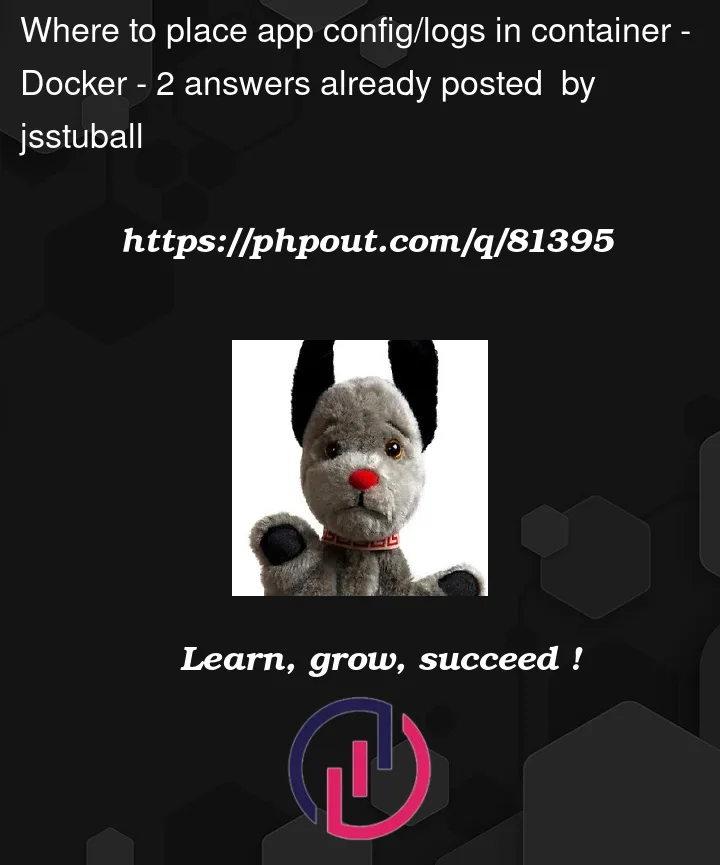I’ve got a python package running in a container.
Is it best practice to install it in /opt/myapp within the container?
Should the logs go in /var/opt/myapp?
Should the config files go in /etc/opt/myapp?
Is anyone recommending writing logs and config files to /opt/myapp/var/log and /opt/myapp/config?
I notice google chrome was installed in /opt/google/chrome on my (host) system, but it didn’t place any configs in /etc/opt/...




2
Answers
Docker is Linux, so almost all of your concerns are related to the best operative system in the world: Linux
Installation folder
This will help you:
and this: Linux File Hierarchy Structure
As a summary, in Linux you could use any folder for your apps, bearing in mind:
Log Folder
Similar to the previous paragraph:
Config Folder
This is the key for devops.
In a traditional, ancient and manually deployments, some folders were used to store the apps configurations like:
But in the modern epoch and if you are using Docker, you should not store manually your settings inside of container or in the host. The best way to have just one build and deploy n times (dev, test, staging, uat, prod, etc) is using environment variables.
One build , n deploys and env variables usage are fundamental for devops and cloud applications, Check the famous https://12factor.net/
And also is a good practice on any language. Check this Heroku: Configuration and Config Vars
So your python app should not read or expect a file in the filesystem to load its configurations. Maybe for dev, but no for test and prod.
Your python should read its configurations from env variables
And then inject these values at runtime:
And in your developer localhost,
Before the run of your application and in the same shell
Config of a lot pf apps
The previous approach is an option for a couple of apps. But if you are driven to microservices and microfrontends, you will have dozens of apps on several languages. So in this case, to centralize the configurations you could use:
Or the Configurator (I’m the author)
I place my apps in my container images in /app. So in the dockerfile I do
WORKDIR /appat the beginningIn container world the best practice is that your application logs go into stdout, stderr and not into files inside the container because containers are ephemeral by design and should be treated that way so when a container is stopped and deleted all of its data on its filesystem is gone.
On local docker development environment you can see the logs with
docker logsand you can:start a container named gettingstarted from the image docker/getting-started:
docker run --name gettingstarted -d -p 80:80 docker/getting-startedredirect docker logs output to a local file on the docker client (your machine from where you run the docker commands):
docker logs -f gettingstarted &> gettingstarted.log &open http://localhost to generate some logs
read the log file with tail realtime or with any text viewer program:
tail -f gettingstarted.logAgain, you can put the config files anywhere you want, I like to keep them together with my app so in the /app directory, but you should not modify the config files once the container is running. What you should do is instead pass the config variables to the container as environment variables at startup with the -e flag, for example to create MYVAR variable with MYVALUE value inside the container start it this way:
docker run --name gettingstarted -d -p 80:80 -e MYVAR='MYVALUE' docker/getting-startedexec into the container to see the variable:
docker exec -it gettingstarted shFrom here it is the responsibility of your containerized app to understand these variables and translate them to actual application configurations. Some/most programming languages support reaching env vars from inside the code at runtime but if this is not an option then you can do an entrypoint.sh script that updates the config files with the values supplied through the env vars. A good example for this is the postgresql entrypoint: https://github.com/docker-library/postgres/blob/master/docker-entrypoint.sh
As you can see, it is not recommended to write logs into the filesystem of the container you would rather have a solution to save them outside of the container if you need them persisted.
If you understand and follow this mindset especially that containers are ephemeral then it will be much easier for you to transition from the local docker development to production ready kubernetes infrastructures.